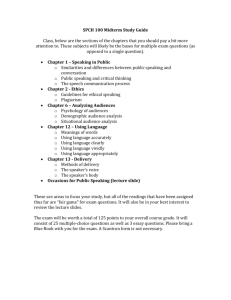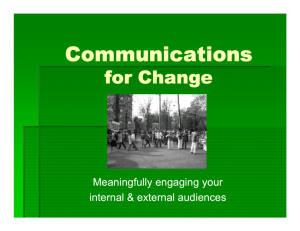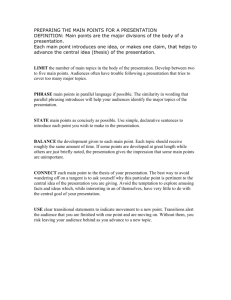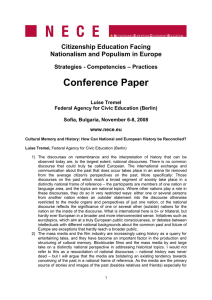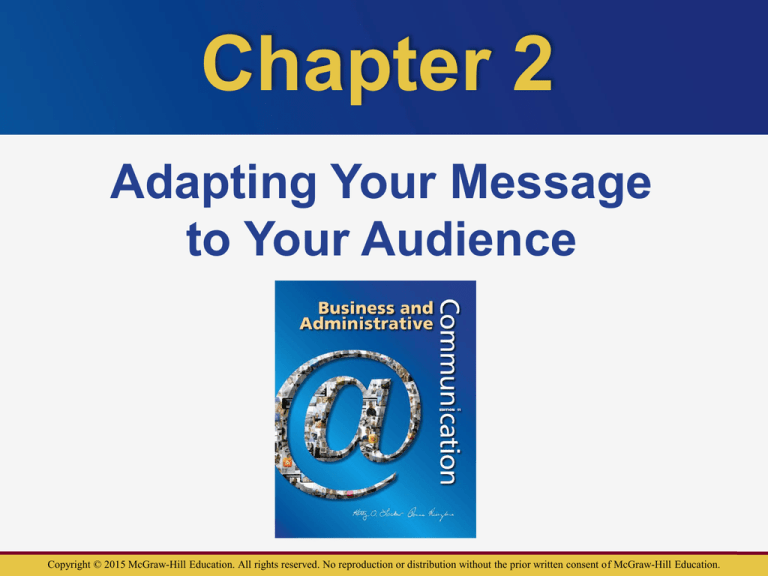
Chapter 2
Adapting Your Message
to Your Audience
Copyright © 2015 McGraw-Hill Education. All rights reserved. No reproduction or distribution without the prior written consent of McGraw-Hill Education.
Chapter 2 Learning Objectives
LO 2-1 How to identify your audience
LO 2-2 Ways to analyze different kinds of audiences
LO 2-3 How to choose channels to reach audiences
LO 2-4 How to adapt your message to the audience
LO 2-5 How to characterize good audience benefits
LO 2-6 How to create audience benefits
LO 2-7 How to communicate with multiple audiences
2-2
Identify Your Audiences
Gatekeeper
Primary
Secondary
Auxiliary
Watchdog
A person can be
in two audiences
2-3
Analyze Your Audiences
Individuals
Group members
Demographics
Psychographics
Organizations
Culture
Discourse community
2-4
Analyze Individuals
People you work closely with
Myers-Briggs Type Indicator – preference
test that shows 4 types
Extrovert-Introvert Which type are you?
Sensing-Intuitive
ISTJ ISFJ INFJ INTJ
Thinking-Feeling
ISTP ISFP INFP INTP
Judging-Perceiving
ESTP ESFP ENFP ENTP
ESTJ
ESFJ
ENFJ
ENTJ
2-5
Analyze Group Members
Focus on common features
Map profile of group features
Demographic (quantity) features
Age – Sex – Education – Income – Race
Psychographic (quality) features
Values – Beliefs – Goals – Lifestyles
VALS (Values & Lifestyle) profile used
2-6
Analyze Organizations
Organizational culture – set of values,
attitudes, and philosophies
Shows in myths, stories, heroes, &
documents
Shows in use of space, money, and power
2-7
To Analyze Organization Culture,
Ask...
Is organization tall or flat?
How do people get ahead?
Is diversity or homogeneity valued?
Is sociability important?
How formal are behavior, language, and
dress?
What does the work space look like?
What are the organization’s goals?
2-8
To Analyze Discourse Community,
Ask...
What channels, formats and styles are
preferred for communication?
What do people talk about?
What topics are not discussed?
What kind of evidence and how much is
needed to be convincing?
2-9
Choosing Channels
Communication channels – means by
which you convey your message
Channels vary by
Speed, accuracy, and cost
Number of messages carried
Number of people reached
Efficiency and goodwill
Choose channels based on the audience,
purpose, and situation
2-10
Six Questions to Adapt Your
Message for Your Audience
1. How
will audience react at first?
2. How much information do they need?
3. What obstacles must you overcome?
4. What positives can you emphasize?
5. What does the audience expect?
6. How will audience use the document?
2-11
Audience Benefits
Advantages audience gets from
Using your services
Buying your products
Following your policies
Adopting your ideas
2-12
Four Criteria for Audience Benefits
1. Adapt
benefits to audience
2. Stress intrinsic and extrinsic ones
3. Prove with clear logic and explain with
vivid detail
4. Phrase benefits in you-attitude
2-13
Identifying & Developing Audience
Benefits
1. Identify
feelings, fears, and needs of
audience
2. Identify objective features of your product
or policy that could meet needs
3. Show how audience’s needs can be met
with those features
2-14
Writing to Multiple Audiences
When not possible to meet everyone’s
needs, analyze gatekeeper and primary
audience to determine
Content and choice of details
Organization
Level of formality
Technical level
2-15


